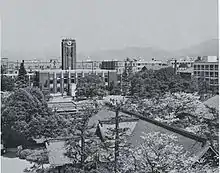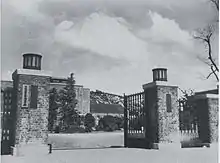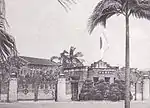Imperial Universities
The Imperial Universities (Kyūjitai: 帝國大學, Shinjitai: 帝国大学, teikoku daigaku, abbr.: 帝大 teidai) were founded by the Empire of Japan between 1886 and 1939, seven in the Mainland Japan (now Japan), one in Korea under Japanese rule (now the Republic of Korea) and one in Taiwan under Japanese rule (now the Republic of China). They were run by the imperial government until the end of World War II.
Today, the Imperial Universities are often described as the former Imperial Universities (旧帝国大学, kyū-teikoku daigaku, abbr. : 旧帝大 kyū-teidai), and are viewed as some of the most prestigious in Japan. These former imperial universities are generally perceived as Japan's equivalent of the Ivy League in the United States, Golden Triangle in the United Kingdom, and the C9 League in China.[1] The alumni club of these nine imperial universities is Gakushikai (学士会).[2]
Unlike Taihoku Imperial University in then-Japanese Taiwan, the Keijō Imperial University in then-Japanese Korea was closed by the United States Army Military Government in Korea (USAMGIK) with U.S. Military Ordinance No. 102. Seoul National University was built by merging nine schools in Seoul and the remaining properties of Keijō Imperial University (Kyŏngsŏng University).
Members
| Imperial Universities | Successor universities | ||||||
|---|---|---|---|---|---|---|---|
| Founded | Name | Image | Present-day name | Location | Map | Colors | Motto |
| 1886 | Imperial University (帝國大學), renamed Tōkyō Imperial University (東京帝國大學) in 1897 |
 |
University of Tokyo (東京大学) | Bunkyō, Tokyo | 35°42′48.39″N 139°45′44.03″E | ||
| 1897 | Kyōto Imperial University (京都帝國大學) |  |
Kyoto University (京都大学) | Kyoto, Kyoto | 35°1′33.77″N 135°46′51″E | Freedom of academic culture (自由の学風) | |
| 1907 | Tōhoku Imperial University (東北帝國大學) |  |
Tohoku University (東北大学) | Sendai, Miyagi | 38°15′14.8″N 140°52′25″E | Practice-Oriented Research and Education (実学尊重の精神) | |
| 1911 | Kyūshū Imperial University (九州帝國大學) |  |
Kyushu University (九州大学) | Fukuoka, Fukuoka | 33°37′21.9″N 130°25′31.1″E | ||
| 1918 | Hokkaidō Imperial University (北海道帝國大學) |  |
Hokkaido University (北海道大学) | Sapporo, Hokkaidō | 43°4′16.61″N 141°20′36.89″E | Boys, Be Ambitious (少年よ、大志を抱け) | |
| 1924 | Keijō Imperial University (京城帝國大學) |  |
Closed by USAMGIK on August 22, 1946, by U.S. Military Ordinance No. 102. Succeeded by Seoul National University | Seoul | Closed | Closed | |
| 1928 | Taihoku Imperial University (臺北帝國大學) |  |
National Taiwan University (國立臺灣大學)[3] | Da'an, Taipei | 25°1′2.45″N 121°32′26.55″E | Integrity, Diligence, Fidelity, Compassion (敦品勵學,愛國愛人) | |
| 1931 | Ōsaka Imperial University (大阪帝國大學) |  |
Osaka University (大阪大学) | Suita, Osaka | 34°49′7.23″N 135°31′26.23″E | Live Locally, Grow Globally (地域に生き世界に伸びる) | |
| 1939 | Nagoya Imperial University (名古屋帝國大學) |  |
Nagoya University (名古屋大学) | Nagoya, Aichi | 35°9′15.8″N 136°57′55.73″E | Courageous intellectual (勇気ある知識人) | |
History

Athletic Competition
The athletic competition started among these seven schools in Japan under the sponsorship of Hokkaido University, formerly known as National Athletic Competition of the Seven Universities (全国七大学総合体育大会, zenkoku nana-daigaku sōgō taiiku-taikai) in 1962. Its name was later recoined as Seven Universities Athletic Meet (国立七大学総合体育大会, kokuritsu nana-daigaku sōgō taiiku-taikai)[4][5] in 2002. The competition is commonly called the Competition of the Seven Imperial Universities (七帝戦, shichi-tei sen) or the national athletic meet of the seven former imperial universities (七大戦, Nanadai-sen).[6]
See also
| Wikimedia Commons has media related to Imperial Universities (Japan). |
- Golden triangle, informal grouping of six universities in Oxford, Cambridge, and London
- Ancient universities in the UK
- Ivy League A formal grouping of elite private universities in the United States
- Group of Eight A formal group of eight universities in Australia
- Institutes of National Importance - A group of premier universities in India
- TU9, alliance of nine leading Technical Universities in Germany
- 4TU, federation of four leading technical universities in The Netherlands
- SKY (universities) A group of prestigious Korean universities
- C9 League The Chinese Ministry of Education's formal grouping of elite universities in China
References
- Sainsbury, Michael (4 November 2009). "China establishes group of Ivy League universities". The Australian.
- 学士会について Archived 2013-02-08 at the Wayback Machine (学士会)
- The Chinese (Kuomintang) government took control of the university and renamed it.
- 51st Seven Universities Athletic Meet Opening Ceremony (July 7, 2012) (Kyoto University)
- UTokyo's Ice Hockey Team Wins at the Seven Universities Athletic Meet for the First Time in 46 Years (Student Support Group) (University of Tokyo)
- Long-awaited overall victory in Nanadai-sen (University of Tokyo)